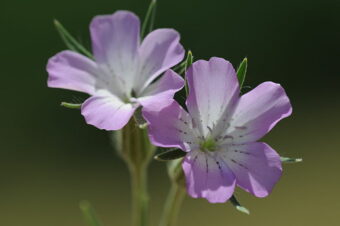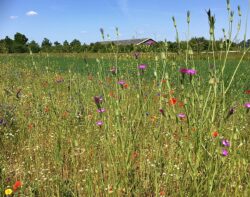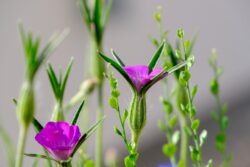In this article, we will be discussing how to grow the wonderful and colourful hardy annual of Agrostemma in containers. It has the common name of corncockle, which is a delightful sounding name for a plant.
It is an excellent plant for cottage garden schemes or for those who like wildlife plants, It is a plant that is commonly found growing in the UK in the past but not so much today due to changes in agricultural measures that has somewhat reduced the plant frequency in farmlands. Agrostemma does have a tendency to self-seed everywhere but growing in containers they make excellent plants.

Agrostemmas are grown for the flowers as the stems are slender and the leaves are hardly noticed below the blooms.
To get the most impact in the container, it is best to grow as a sole species as otherwise, you will see the flowers and little else.
The flowers are geranium-like and tend to be magenta and purple in colour. Flowers are produced between June and August and because they can take wind and rain, it is recommended to grow these plants in the open, where they can take all weather thrown at them. Not only that, they make an excellent cut flower.
This article will show you what some gardeners treat as a weed, will make an attractive addition to the container garden.
GROWING AGROSTEMMA IN CONTAINERS
You can only grow Agrostemma directly in containers, as they do not transplant easily. They absolute hate root disturbance and so you will need to sow the seeds in situ.
You will need to choose a container that is suitable for the plant in question. Make sure it is well balanced and has plenty of drainage holes.

To the container add multipurpose compost near the rim and firm it well at the surface. From March to May, add a thin layer of seed compost and on top of this sprinkle the seeds on top. Cover lightly with more sieved compost and wait for the seeds to germinate. Once the seeds have germinated thin seedlings to 20cm apart, so it is advised to use long trough-like containers to get the best displays.
It prefers to be grown in full sun but it does not like soggy compost. This is why having drainage holes is of the utmost importance.
Agrostemma will appreciate being watered when the compost feels dry to the touch but not too much to make the compost soggy.
Do not fertilize at all during the growing season, as it prefers to grow in poor compost. Apart from watering, the plant will need little in the way of care. It will not even need deadheading.
PESTS AND DISEASES
The good news is that corn cockle does not suffer from any noticeable pests and diseases.
VARIETIES TO GROW

All varieties that you grow are based on Agrostemma githago that have narrow, hairy green leaves and bright magenta blooms that close at night. ‘Milas’ is the usual variety to grow that has 5cm wide flowers that are pale pink fading to white at the centre.
‘Alba’, ‘Snow Queen’, ‘Bianca’ and ‘Ocean Pearls’ has large white flowers instead of the magenta often commonly found with these species.
‘Cerise’ has bright pink flowers that are more notable than the Milas variety.
CONCLUSIONS
In this article, we have discussed how to grow this wonderful hardy annual of Agrostemma in containers. They may look like weedy plans but in the right containers with the right growing conditions, they make wonderful plants to give much summer colour. They will also provide much welcome food for beautifies and bees.
A plant that once grew wild and has become rarer, can be grown in the garden.
If you have any questions or comments that you wish to make on growing Agrostemma in containers, please do so in the comment box below.
Happy Agrostemma growing.
